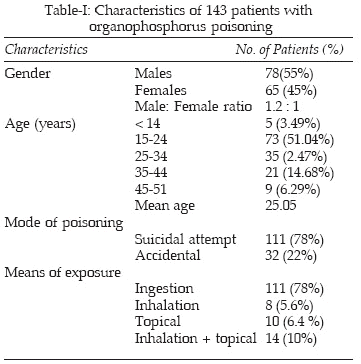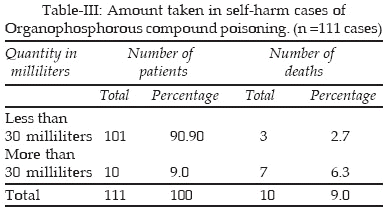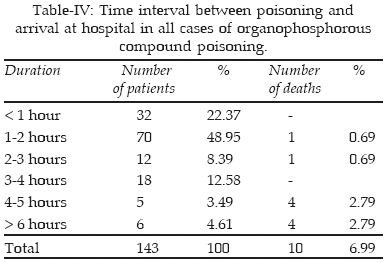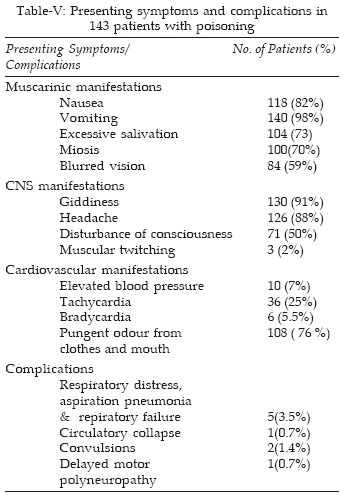|
|
||||
|
Published by : PROFESSIONAL MEDICAL PUBLICATIONS |
||||
|
ISSN 1681-715X |
||||
|
||||
|
- |
||||
|
ORIGINAL ARTICLE |
||||
|
- |
||||
|
Volume 22 |
July - September 2006 |
Number 3 |
||
|
|
||||
|
|
||||
|
|
||||
|
Published by : PROFESSIONAL MEDICAL PUBLICATIONS |
||||
|
ISSN 1681-715X |
||||
|
||||
|
- |
||||
|
ORIGINAL ARTICLE |
||||
|
- |
||||
|
Volume 22 |
July - September 2006 |
Number 3 |
||
|
|
||||
|
|
||||
The analysis of organophosphates
poisoning cases treated at Bahawal
Victoria Hospital, Bahawalpur in 2000-2003
Muhammad Imran Suliman1, Rushd Jibran2, Manzoor Rai3
ABSTRACT
Objective: To study the socio demographic pattern and mode of presentation of organophosphorous intoxication in Southern Punjab, Pakistan.
Settings: The study was conducted in the department of Medicine, Bahawal Victoria Hospital, Bahawalpur from April 2000 to March 2003.
Design: Descriptive study.
Methods: One hundred and forty three cases of organophosphorous compound poisoning, admitted through the emergency department, were evaluated in the study. In all the cases a previously established clinical and therapeutic protocol was applied and the outcome was recorded.
Results: Seventy-eight (54.54%) patients were male, Sixty five (45.45%) were female with the mean age of 25.04 years. One hundred and eleven (77.62%) cases were attempted suicides and 32 cases (22.37%) were due to accidental events. Mean age was 22.1 years in the 111 suicidal cases (77.62%) and 78 (70.27%) of them were less than 24 years. Among the suicide attempts, 63 (56.75%) were female patients. The attempted suicide proportion was 61.53% in men and 96.92% in women. Sixty six per cent of cases were illiterate and 47.55% of the patients were in the lower middle socioeconomic status. The patients’ mean arrival time to the hospital after poisoning was 2.1±6.01 hours. Exposure routes were gastrointestinal in 111 patients (77.62%), respiratory in 8 patients (5.59 %), dermal in 10 patients (6.99%) and both dermal and respiratory in 14 (9.79%). Death of 10(6.99%) patients was related to either the ingestion of higher doses or delay in approaching the hospital for emergency management.
Conclusion: Causes of poisoning (suicide vs non-suicide) and time interval between poisoning to arrival at hospital were major determinants of lethality. These findings call for a shift in emphasis in educating the masses towards first-aid care for intoxication.
KEY WORDS: Organophosphorous compound, Poisoning, Suicide, Intoxication.
Pak J Med Sci July - September 2006 Vol. 22 No. 3 244-249
1. Dr. Muhammad Imran Suliman FCPS
Assistant Professor Medicine,
Women Medical College, Abbottabad.
2. Dr. Rushd Jibran FCPS
Medical Officer,
Punjab Institute of Cardiology,
Lahore.
3. Dr. Manzoor Rai FCPS
Associate Professor,
Department of Pediatrics,
Women Medical College
Abbottabad.
Correspondence:
Dr. Muhammad Imran Suliman
E-Mail: drimranbwp@gmail.com
imran_suliman@yahoo.co.uk
* Received for Publication September 22, 2005
*
Revision Accepted March 25, 2006Introduction
Organophosphorous compound poisoning from occupational, accidental and intentional exposure is a global problem, especially in developing countries.1 Its toxicity is based on inhibition of acetyl cholinesterase, culminating in accumulation of acetylcholine at the synapses.2 Initially, majority of patients presents with florid cholinergic symptomatology.3 Severe intoxication can lead to bronchorrhea, respiratory depression, fasciculations and altered sensorium.4 Quantifying acetylcholine can help in the diagnosis.2
Hazardous occupational and risky storage of pesticides put safety of millions of people in jeopardy. Irrational frequent sprays in high concentration pose risk to farmers.5 Promotion of necessary precautions through education and training the farmers are proving ineffective. Interestingly recognition of toxicity is resulting in paradoxical rise of such cases. Most of the villagers have stocks of these compounds at houses, readily available for deliberate self-poisoning.6 Suicidal intake of pesticides is a huge burden on health services and causing extremely higher case fatality rate than accidental oisoning.7-9 Jeyratnam reported in 1990 that suicidal cases of organophosphorous poisoning were exceeding two million per year with 200000 deaths whereas one million cases were attributed to accidental/occupational exposure resulting in death of 20000.10
In this study we investigated the sociodemo- graphic pattern of organophosphorous intoxication and tried to establish the determinants which are responsible for such cases.
PATIENTS AND METHODS
This is a descriptive study of 143 patients of organophosphorous compound poisoning presenting at Bahawal Victoria Hospital, Bahawalpur, Southern Punjab, Pakistan. Cases were admitted through emergency department and diagnosed on the basis of history of ingestion/exposure of the compound. Attendants of the patients were asked to bring the bottle through which the patient took the poison. Some of them were already carrying the container with them. While diagnosing these cases, clinical signs suggestive of muscarinic involvement like excessive salivation, sweating, miosis, and typical odour of the compound in breath and clothes were also taken into account. Finally improvement with intravenous atropine was thought to confirm the diagnosis. Other agrochemicals, parquat or drugs poisonings were not entertained in the study. Reduction in cholinesterase activity in plasma and red blood cells is the way to confirm the diagnosis but non-availability of such investigations at Bahawalpur was a hindrance.
Data collected includes age, gender, education, employment and marital status, address, socioeconomic levels, time, dose and route of exposure of the toxic agents, frequency of different clinical features, treatment before admission, duration of hospitalization and complications. Awareness of patients about the poisonous substance was recorded and previous attempt of suicide with history of psychiatric consultation and management was also inquired.
Gastric lavage was done in all patients and atropine 2mg intravenously was given in repeated boluses until complete atropinization was achieved. Subsequently atropine was administered according to the patient’s clinical situation. A small number of the patients had to be put on circulatory and respiratory support.
Patients admitted with intentional intake and suicide attempt were referred for psychiatric assessment. All patients and their attendants were given telephone number to obtain follow-up interview.
Results
The major characteristics of 143 patients along with mode and means of exposure of poisoning is given in Table-I. The youngest patient was 12 years of age and the oldest was 51. Most of the poisoning occurred in summer months: July (20), August (84) and September (28).

Table-II shows the socio-economic class and their education levels. Majority (102, 71%) belonged to lower middle and upper middle class. All the patients of lower class were illiterate. The precipitating factors for the use of poisoning in 111 suicidal cases included marital friction in 32(28.8%), strained social relation in 27(24.3%), financial stress in 16(14.4%), unemployment in 15(13.5%), failure in love affair in 15(13.5%), failure in exams in 2 (1.8%) and chronic illness in 2(1.8%).

Most frequently used organophosphorus compound was Methamedophos, followed by chlorpyriphos, profinophos/cypermethrine, melathion, monochlorotophos and demeton-S-methyl.13 patients were not aware of the brand of the substance used. Out of 111 suicidal cases, 101(91%) used < 30 ml of the poison and 3 patients (2.7%) died, while 10 patients (9%) consumed >30 ml and 7 patients (6.3%) died. (Table-III)

Table-IV indicates the patient arrival time to hospital after the poisoning. The time ranged from 45 minutes to 15 hours with a median of 1-2 hours. The longer time gap between the use of poison and the arrival in hospital determined the increased deaths. Before arrival at hospital only 50 patients received some medical aid at the periphery which uncluded gastric lavage and intravenous line. Only one patient received atropine injection by the local physician.

Ten patients (6.9%) died and all of them belonged to the suicidal group. The deaths were related to larger amounts of the poison consumed and the delayed arrival in the hospital.

DISCUSSION
Organophosphorous compounds account for two million suicide attempts and one million accidental poisoning each year worldwide.10 These are the most significant poisons in Asia, being both widespread and coupled with a towering mortality rate. In several areas, some pesticides have become the trendiest method of suicide, gaining unsavory reputation amongst both health-care personnel and community.11 In agricultural areas of Srilanka the agent responsible for 77% of the deaths was pesticides.12 Self-poisoning with pesticides is uncommon in urban areas.
In agricultural countries like Pakistan, toxicity of pesticides as well as lack of medical services is taking its toll in the form of high case fatality rates. Few data are available on the organophosphorous compound poisons most commonly used in cotton producing Southern Punjab. So an attempt was made to carry out a study at Bahawalpur to observe the sociodemographic and clinical features of organophosphorous intoxication.
In this study, most of the victims of poisoning were in the age group of 15-24 years. In a study at Ahmedabad, India, patients’ age ranged from 11-60 years with maximum number of cases between the ages of 21-30 years.13 In another small study at Jan Bozy Provincial Hospital in Lublin, age range was 13-85 years and most of the patients belonged to 51-60 years age group.14 In Kamenczak study the highest number of poisonings was noted in age group 30-39 years.15 The youngest age group affected in Pakistan is worrisome.
Overall male to female ratio was 1.2:1 in our study. Casey P et al reports16 study male to female ratio was 2.4:1 but Guloglu17 found male to female ratio of 1:3.5 in his study of 170 cases. However females exceeded males in the intentional intake of the substances 63 vs 48 (with the ratio of 1.3:1) while reverse trend was observed in accidental cases (total=32) where only two females were among the victims (6.25% of the accidental cases). According to Sahin the attempted suicide proportion was 46.4% in men and 75.4% in women.18 Van der Hoek W reports that suicidal intake of organo phosphates is more prevalent among males as compared to females in Srilanka.5
Agarwal found that 67.4% of the cases had the intention of committing suicide, 16.8% of the cases were the result of occupational exposure, and 15.8% of the cases were from accidental poisoning.13 Our results are in line with their findings.
More than half of the patients were married (54.54%) but married females were found to be more prone to self-harm as compared to married males. Total cases who took poison due to disturbed marital life were 32 and 30 of them were females. These results are making the study different from what has been observed in other countries. For example in Southeast Anatolian region of Turkey, OP intoxication especially affected young unmarried females, and most of them resulted from a suicidal purpose.17
Majority of the enrollments happened during the month of August reflecting the easy availability of the organophosphorous compound poisoning in the peak spray season on cotton plats. In Diyarbakir, Turkey, most plants intoxication cases occurred during the summer season (93 of 170 patients) on a monthly basis, admissions during April, May and July were most common.17
Maximum patients belonged to lower middle class and only 34 patients were having qualifications up to secondary school level or above. Eleven cases were having previous history of suicide in the past and 21% patients were having previous history of psychiatric illness. In cases of Kara, most of them had a primary education level (66.7%) and a lower socioeconomic status (58.3%).19 Hence illiteracy and poverty are also major factors to compel the people to commit suicide.20
In this study, quantity of poison ingested and time interval between poisoning and arrival at hospital were directly linked to the death. Ten males took more than 30 ml of the liquid and seven of them died. In the same manner eleven patients reached hospital with a delay of >4 hours and 8 of them died. In a study conducted in Indian administered Kashmir 90 percent had consumed 5 to 50 ml of organo phosphates; the rest had taken more. About 80 percent were seen within two to four hours. Nine patients died, and 155 recovered.21 In Yuzuncu Yil University Medical Faculty Hospital, Turkey the patients’ mean arrival time to the hospital after poisoning was 4.4± 3.7 (1-15) hours and in that study only four (4.7%) of them died.18 Sheu JJ reported 23% of case fatality rate in organophosphorous compound poisoning in Taiwan.1
In contrast to the claims of relative safety of some brands, no difference was observed in the frequency of symptoms and complications in accidental cases of poisoning. Among the symptomatology vomiting, giddiness and headache were more frequent. Three patients were having fasciculations at presentation. The frequency of these symptoms is almost similar to what reported in previous studies.22-24
Most of the patients were having tachycardia in casualty before administration of atropine and ten (6.99%) patients experienced raised blood pressure and sinus tachycardia36 (25.17%). In Kara IH study, according to ECG examination, tachycardia (14, 58.3%), ST changes (13, 54.2%), and T changes (3, 12.5%) were mostly seen; bradycardia and serious ventricular arrhythmias were not seen in any case.19 But in our study bradycardia was seen in 5.59% of cases. These values correlate with the results of other studies conducted by Agarwal et al.25 Inhibition of acetyl cholinesterase enzyme activity in blood was not determined due to non-availability of the test at our center.
The time interval between poisoning and treatment is very crucial in the prognosis of such cases. Medical personnel involved with primary care should be accustomed to deal with such problems and provide their patients with the necessary management. One third of the patients were given some sort of therapy before shifting to our center and only one of them received antidote. These findings demand a swing in emphasis in community education towards first-aid management of poisoning cases. Medical authorities should be steered to supply proper resuscitative equipment, and guarantee a regular delivery of drugs to all primary health care centers. Treatment of organophosphorous compound poisoning should be stressed in the syllabus for health care workers. Firm rules and regulations concerning the trade, delivery and storage of such chemicals should be followed in order to reduce the incidence of poisoning and resulting mortality.
Conclusion
The death in poisoning cases depended on a variety of factors like the organophosphorous substance and quantity taken, the duration between poisoning and hospitalization. Illiteracy, poverty and female gender are among the major inciting agent for suicidal impulsive behavior. Probability of improvement was high when the patient was taken to hospital as soon as possible. Confinement of unsafe pesticides away from houses will reduce the accessibility for impulsive act. Hopefully, non-chemical methods of pest control will put a stop to acute organophos- phorous compound poisoning.
REFERENCES
1. Sheu JJ, Wang JD, Wu YK. Determinants of lethality from suicidal pesticide poisoning in metropolitan HsinChu Vet Hum Toxicol. 1998; 40(6): 332-6.
2. Muhammad NK, Shamim H. Deliberate self harm due to organophosphates. JPIMS 2003; 14 (2): 784-9.
3. Khurana D, Prabhakar S. Organophosphorous intoxication. Arch Neurol 2000; 57: 600-2.
4. Yelmos F, Diez F, Martin C, Blanco JL, Garcia MJ, Lardelli A, Pena JF. Acute organophosphate insecticide poisonings in the province of Almeria: A study of 187 cases. Med Clin (Barc) 1992; 98(18): 681-4.
5. Vander Hoek W, Konradsen F, Athukorala K, Wanigadewa T. Pesticide poisoning: a major health problem in Sri Lanka. Soc Sci Med. 1998; 46: 495-504.
6. M. Eddleston. Patterns and problems of deliberate self-poisoning in the developing world. Q J Med 2000; 93: 715-31.
7. Hettiarachchi J, Kodithuwakku GCS. Pattern of poisoning in rural Sri Lanka. Int J Epidemiol1989; 18:418–22.
8. Ingianna J, Herrero R, Albertazzi C. Estudio comparativo de casos de intoxicaciones por insecticidas organofosforados en diferentes zonas de Costa Rica. Revista Biol Trop 1983; 31:139–44.
9. Abdollahi M, Jalali N, Sabzevari O, Hoseini R, Ghanea T. A retrospective study of poisoning in Tehran. Clin Toxicol 1997; 35:387–93.
10. Jayaratnam J. Acute pesticide poisoning: a major global health problem. World Healthstate Q 1990; 43:139-44.
11. Eddleston M, Sheriff MHR, Hawton K. Deliberate self-harm in Sri Lanka: an overlooked tragedy in the developing world. BMJ 1998; 317:133–5.
12. Karalliedde L, Senanayake N. Acute organophosphorus insecticide poisoning in Sri Lanka. Forensic Sci Int. 1988; 36:97–100.
13. Agarwal SB. A clinical, biochemical, neuro- behavioural and sociopsychological study of 190 patients admitted to hospital as a result of acute organophosphate poisoning. Environ Res 1993; 62:63–70.
14. Gnyp L, Lewandowska SH. The analysis of organophosphates poisoning cases treated at the Centre for Acute Poisonings in Lublin Provincial Hospital in 1994-1996. Przegl Lek 1997; 54(10):734-6.
15. Kamenczak A, Jasinska-Kolawa K, Targosz D, Szkolnicka B, Sancewicz-Pach K. Acute pesticides poisoning in the Krakow department of clinical toxicology in 1986-1995. Przegl Lek. 1997; 54(10):671-6.
16. Casey P, Vale JA. Deaths from pesticide poisoning in England and Wales: 1945-1989. Hum Exp Toxicol 1994; 13(2): 95-101.
17. Guloglu C, Kara IH. Acute poisoning cases admitted to a university hospital emergency department in Diyarbakir, Turkey. Hum Exp Toxicol 2005; 24(2):49-54.
18. Sahin HA, Sahin I, Arabaci F. Sociodemographic factors in organophosphate poisonings: a prospective study. Hum Exp Toxicol 2003; 22(7):349-53.
19. Kara IH, Guloglu C, Karabulut A, Orak M. Sociodemographic, clinical, and laboratory features of cases of organic phosphorus intoxication who attended the Emergency Department in the Southeast Anatolian Region of Turkey. Environ Res 2002; 88(2):82-8.
20. Gunnel DJ, Peters TJ. Relations between para-suicide, suicide, psychiatric admissions and socioeconomic deprivation. BMJ 1995; 311:266.
21. Malik GM, Mubarak M, Romshoo DJ. Organophosphorous poisoning in the Kashmir valley, 1994-1997. New Engl J Med 1998; 338(15):1078-9.
22. Rivera JA, Rivera M. Organophosphate poisoning. Bol Asoc Med P R. 1990; 82(9):419-22.
23. Nalin DR. Epidemic of suicide by malathion poisoning in Guyana. Trop Geogr Med 1973; 25:8–14.
24. Eungprabhanth V. Suicide in Thailand. Forensic Sci 1975; 5:43–51.
25. Ozyurt G, Yilmazlar A, Tamagac F. The myocardium and brain SPECT findings in organophosphorous poisoning. Eur J Emerg Med 1997; 4 (1):29-31.
HOME | SEARCH | CURRENT ISSUE | PAST ISSUES
Professional
Medical Publications
Room No. 522, 5th Floor, Panorama Centre
Building No. 2, P.O. Box 8766, Saddar, Karachi - Pakistan.
Phones : 5688791, 5689285 Fax : 5689860
pjms@pjms.com.pk